Oklahoma City bombing survivor recalls miraculous rescue 30 years later
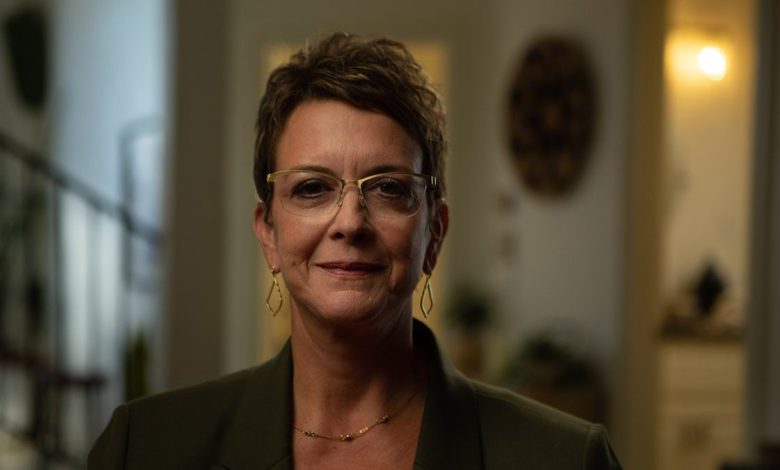
April 19, 1995, started off as a beautiful spring day for Amy Downs, a teller at a credit union inside the Alfred P. Murrah Federal Building in Oklahoma City.
“I remember the red buds were blooming,” Downs recalled to Fox News Digital. “I was so excited. I was getting ready to close my very first house. I don’t think I did any work in that first hour of the day. I was running around talking to all my friends about the house.
“And then I was looking at my watch, thinking, ‘Oh gosh, it’s almost nine o’clock. I’m going to get in trouble. I had better get back to my desk.’”
Downs flew past her boss. A co-worker who was six months pregnant sat beside her. Downs asked if she needed anything.
OKLAHOMA CITY BOMBING: FBI AGENT REFLECTS ON RESPONSE TO ATTACK 29 YEARS LATER
Amy Downs is speaking out in National Geographic’s “Oklahoma City Bombing: One Day In America.” (National Geographic/Brandon Widener)
“I don’t know if the words even came out of my mouth or not, because that’s when the bomb went off and everything went black,” Downs said.
It was 30 years ago when a truck bomb detonated outside a federal building in America’s heartland, killing 168 people in the deadliest homegrown attack on U.S. soil. Downs and other survivors and witnesses are speaking out in a new National Geographic docuseries, “Oklahoma City Bombing: One Day in America.”

April 19, 1995, started as a beautiful spring day for Amy Downs. Then her life forever changed. (National Geographic/News9 Oklahoma City)
“I think it’s so important to remember what happened and the lessons that were learned,” Downs said of why she chose to come forward.

A rubble pile and heavy damage are visible at the Alfred P. Murrah Federal Building on the afternoon of April 19, 1995, in Oklahoma City, Okla. (National Geographic/Danny Atchley)
Downs was 28 years old when she found herself trapped upside down in her office chair. She had fallen three floors down and was buried under 10 feet of rubble. Whenever she gasped for air, it burned down to her chest. Her body was pierced with glass.
“I remember hearing roaring and screaming, and this powerful rushing sensation, like I was falling,” said Downs. “I found out I had fallen. … I couldn’t move. I couldn’t see. It was very hard to breathe. I had no idea what had happened. I just knew it was bad.”

Firefighters ran through thick smoke toward the Alfred P. Murrah Federal Building. (National Geographic/Danny Atchley)
Downs screamed for help, but no one replied. In the darkness, she heard silence. Suddenly, after what felt like an eternity, there was a sudden commotion of firefighters. One said, “Let’s split up. Let’s look for the daycare babies.”
SIGN UP TO GET TRUE CRIME NEWSLETTER
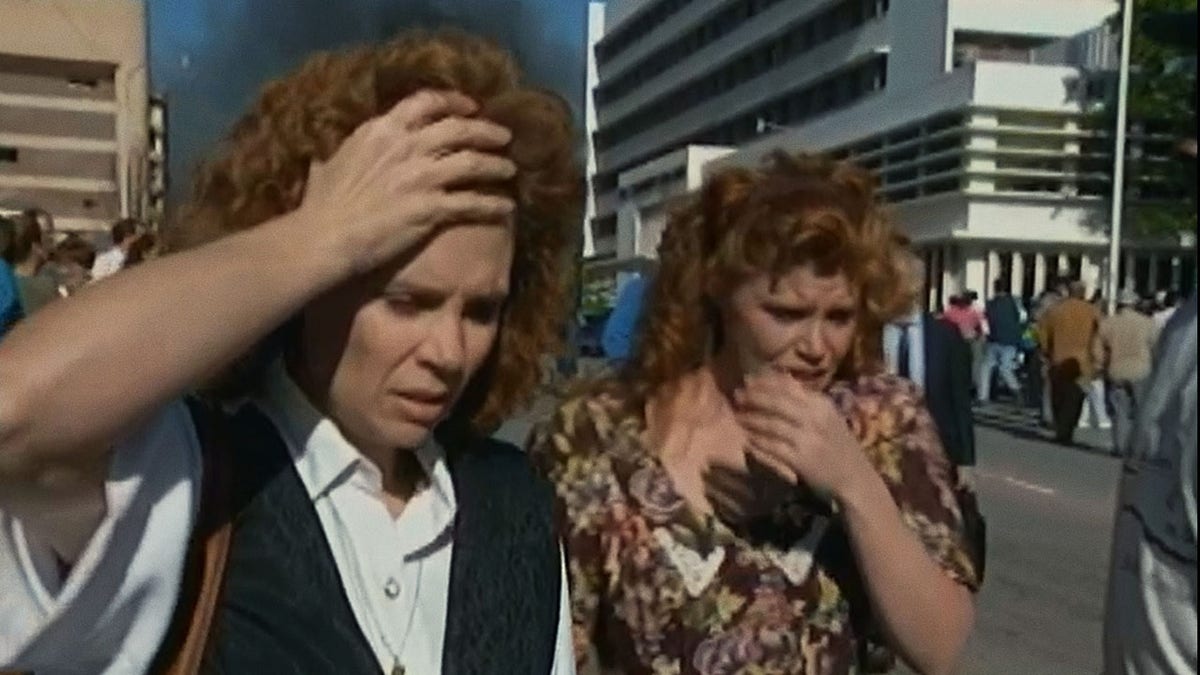
Edye Raines and her mother, Kathy Sanders, realize the blast occurred in the building where America’s Kids Daycare is located. (National Geographic/News9 Oklahoma City)
They were referring to the children at the America’s Kids Daycare inside the building.
“I was confused,” said Downs. “I thought, ‘Why are they looking for the daycare babies here? The daycare is on the second floor, and we’re on the third floor.’ I had no idea that we were at the bottom of what was once this nine-story building.”

Rescue workers search through the rubble looking for survivors. (Roman Bas/AFP via Getty Images)
Fire Chief Mike Shannon heard Down’s cries for help. Just as he was about to go get her, his crew learned there was a possibility of another bomb that was about to go off. It forced them to immediately evacuate, leaving Downs behind.

District Fire Chief Mike Shannon heard Amy Downs’ cries for help. (National Geographic)
Shannon was determined to stay with Downs, but fellow firefighters refused to leave him behind. In the documentary, Shannon described how he heard the echoes of Downs sobbing, begging him to save her, as he was being rushed out.
At that moment, Downs believed her life was coming to an end.
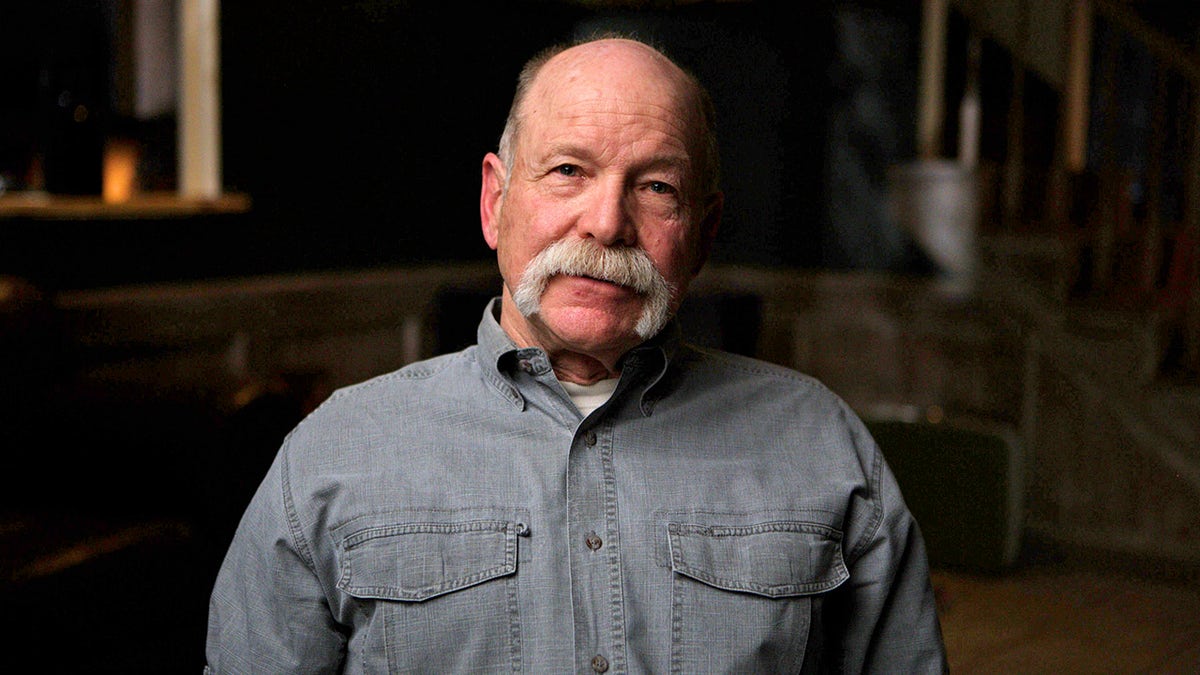
Mike Shannon recalled hearing Amy Downs’ pleas for help. (National Geographic/Brandon Widener)
“I now knew it had been a bomb, and it looked like there was another one,” she said. “I was getting ready to die. I prayed, or maybe you could call it bargained with God. I kept promising God anything, just to be able to live. I prayed for a second chance. My reality was that I was 28 years old and getting ready to die, and I’ve never really lived. I had a lot of regrets about how I had not been living.”
SIGN UP TO GET TRUE CRIME NEWSLETTER

Panicked onlookers, survivors and first responders clear the area after the threat of a possible second explosive device in the Alfred P. Murrah Federal Building April 19, 1995, in Oklahoma City. (National Geographic/News9 Oklahoma City)
In between tears, she began to recite portions of Psalm 23 to comfort herself.
“The only thing I could remember was, ‘I walked through the valley of the shadow of death,’” said Downs. “I couldn’t remember what came next. I thought that was awful. And then, of all the weird things to do, a song popped into my head that we used to sing growing up in church. I started singing this song, and I felt peace. This was the first time that I thought I was at peace with what was getting ready to happen.”

Luke Franey, who had just escaped through the rubble, is led away. (National Geographic/News9 Oklahoma City)
There was no second bomb. Once the firefighters realized this, they rushed back in. Shannon remembered to look for Downs. When Downs heard the sounds of men again, she promised in the darkness to bake them, anyone, chocolate chip cookies if they could save her.

Amy Downs speaking to her mother from the hospital bed after her rescue. (National Geographic/KFOR-TV)
Six and a half hours later, she was free.
“I was in the hospital for about eight days,” she said. “The biggest injury was my leg, which had been split open. My bone was intact, but the leg was open. But the hardest part was finding out that 18 of my 33 co-workers were killed. … Grief is something that I couldn’t comprehend. Dealing with the grief and trauma was the hard part. The injuries were nothing.”

President Bill Clinton departs the White House briefing room in Washington, D.C., April 19, 1995, after meeting with reporters to discuss the bombing. (National Geographic/Marcy Nighswander/The Associated Press)
Downs was one of the last survivors to be pulled from the rubble after the bombing, which killed 168 people, including 19 children. Nearly 700 others were injured.
GET REAL-TIME UPDATES DIRECTLY ON THE TRUE CRIME HUB

The Oklahoma City bombing killed 168 people, including 19 children. (Joe Raedle/Getty Images)
Downs struggled with survivor’s guilt.
“I remember on the eighth day in the hospital, they found my best friend’s body,” she tearfully said. “She had baby girls at home.”

District Fire Chief Mike Shannon confers with a colleague at the site of the bombed Alfred P. Murrah Federal Building in Oklahoma City. (National Geographic/Danny Atchley)
As Downs grieved, the community banded together. In just 72 hours after the bombing, 7,000 people waited in line to donate blood, FOX25 reported.

An Oklahoma City firefighter walks near explosion-damaged cars on the north side of the Alfred Murrah Federal Building in Oklahoma City after a car bomb explosion April 19, 1995, in Oklahoma City. (National Geographic/Jim Argo/USA Today Network)
“We have our differences, and differences are not a bad thing,” she said. “But I think it’s cool when we know when to put aside those differences and come together for good.”
Downs was still in the ICU when she saw a group of nurses glued to a television screen. It was revealed that the bombing was orchestrated by two former U.S. Army buddies, Timothy McVeigh and Terry Nichols.

Timothy McVeigh is pictured sitting on his car while he was selling anti-government bumper stickers at Mount Carmel, Waco, during the ATF/FBI standoff with the Branch Davidians in April 1993. (National Geographic/Michelle Rauch/Courtesy FBI Multimedia)
They shared a deep-seated hatred of the federal government fueled by the bloody raid on the Branch Davidian religious sect near Waco, Texas, and a standoff in the mountains of Ruby Ridge, Idaho, that killed a 14-year-old boy, his mother and a federal agent.
CLICK HERE TO GET THE FOX NEWS APP

Timothy McVeigh is escorted out of the Noble County Courthouse in Perry, Okla., to be transferred to Tinker AFB for his arraignment April 21, 1995. (National Geographic/News9 Oklahoma City)
“When I found out that it was an American, not only that, but somebody who also served in our military … I struggled with that,” she said. “I could not wrap my brain around that. My father is from the Greatest Generation. He lied about his age when he was 17 years old to fight World War II. It just didn’t add up. How could you be an American? How could you serve our country? How could you do this?”
According to the documentary, Downs later faced McVeigh in court.
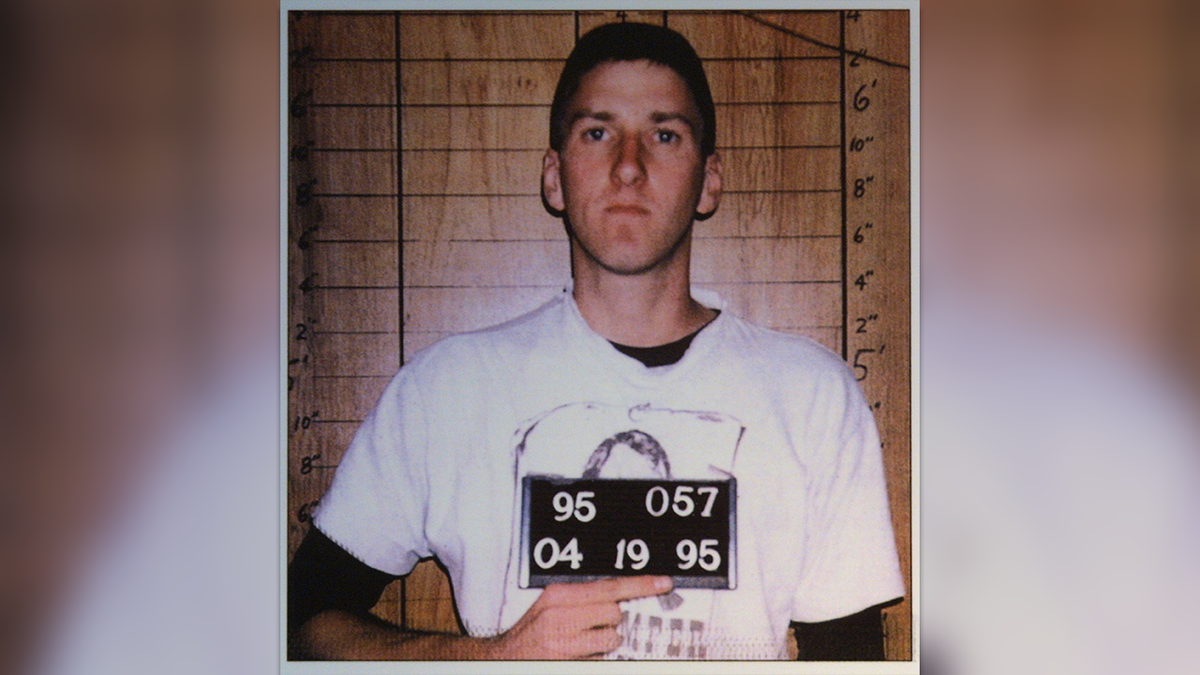
Timothy McVeigh was executed in 2001. (Getty Images)
“It was very disturbing,” she said, shuddering. “He almost seemed proud of it.”

Terry Nichols was convicted of being an accomplice to Timothy McVeigh in the Oklahoma City bombing of the Alfred P. Murrah Federal Building. (Bureau of Prisons/Getty Images)
McVeigh was executed by lethal injection in 2001. He was 33. Nichols, now 70, is serving life in prison without the possibility of parole.
Downs was ready to embrace her second chance at life. She went from a 355-pound “couch potato” to losing 200 pounds and completing a full ironman triathlon. She went on to work for the same credit union, now called Allegiance Credit Union, where she served as president and CEO.

Amy Downs said, after her rescue, she was determined to turn her life around. (National Geographic/Danny Atchley)
“I’d flunked out of college because I couldn’t pass a math class,” she said. “But I was very fortunate to have bosses who mentored me and believed in me. … I had promised God that I would never live my life the same if I survived, and I meant that. … I went back to college, got my degree, did all the things. … And just this week, I retired. So, I decided to launch a new chapter.”
WACO DOC: CULT LEADER DAVID KORESH ‘NEEDED TO FULFILL HIS DESTINY,’ RESULTING IN HORRIFIC TRAGEDY

Mike Shannon is featured in the National Geographic docuseries “Oklahoma City Bombing: One Day in America.” (National Geographic/Brandon Widener)
Today, Downs is a full-time speaker. She also created a new bucket list. She and her sister are planning to walk about 160 miles of Camino de Santiago, a pilgrimage known as “The Way of St. James.” She’s also eager to ride her bicycle across the United States.
“I’m still trying to figure out what I want to be when I grow up,” the 58-year-old chuckled.
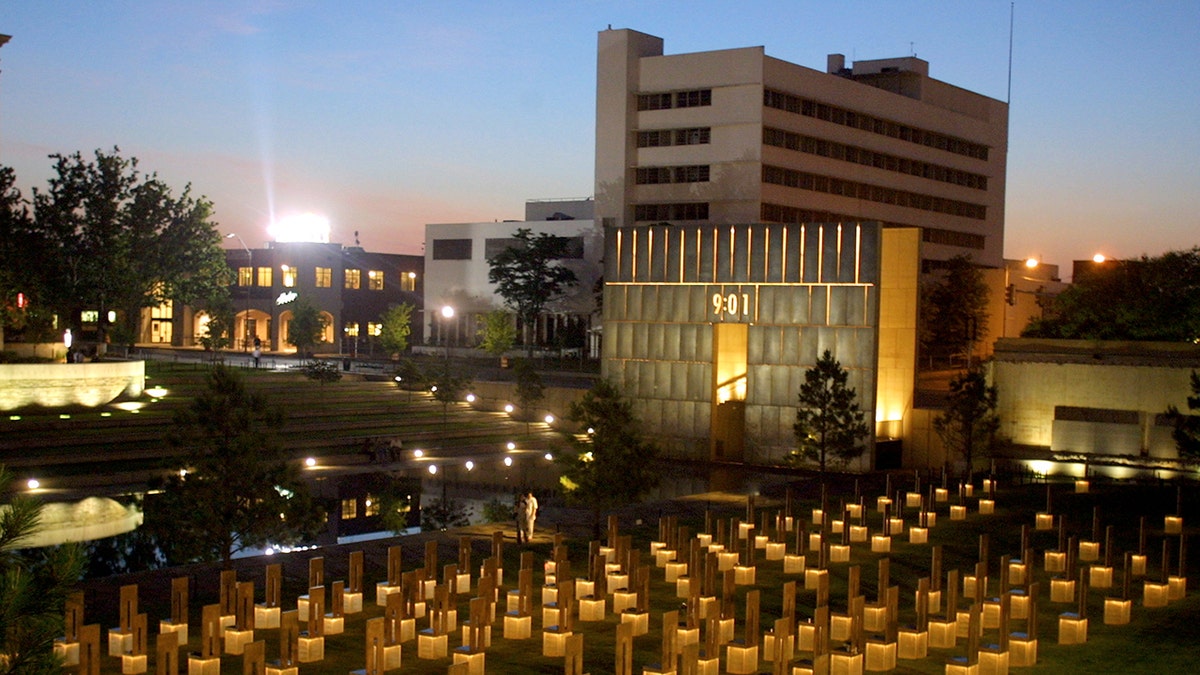
The Oklahoma National Memorial on the day of Timothy McVeigh’s execution June 11, 2001, in Oklahoma City, Okla. (Joe Raedle/Getty Images)
Downs hopes viewers watching the documentary will learn how a community became united during tragedy.

Floral tributes commemorate the 19 children killed in the Oklahoma City bombing at the base of the Alfred P. Murrah Federal Building in April 1995. (National Geographic/Courtesy The Stephen Jones Oklahoma City Bombing Archive, Dolph Briscoe Center, at the University of Texas)
“It showcases the strength of the human spirit and the courage of these men who rushed in to help,” she said. “And the way we came together. The thing is, we are all going to face times in our lives when we’re buried under the rubble, where devastation comes to us. … We will face difficult times.
“I think the lesson from this is that, as people, we can come together. And when you come together during times of difficulty, you are stronger than you realize. And together, you will get through it.”
National Geographic’s “Oklahoma City Bombing: One Day in America” is now streaming on Hulu and Disney+. The Associated Press contributed to this report.



